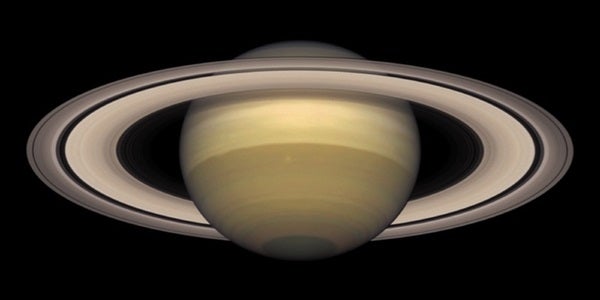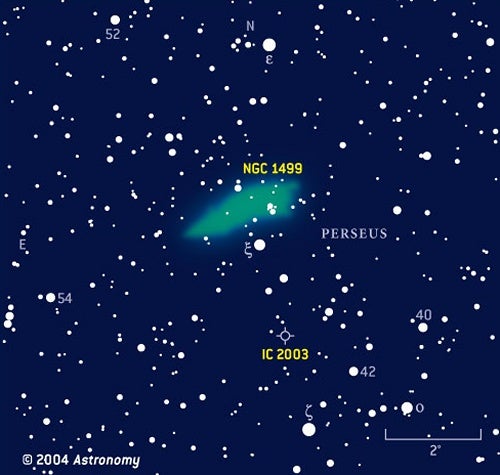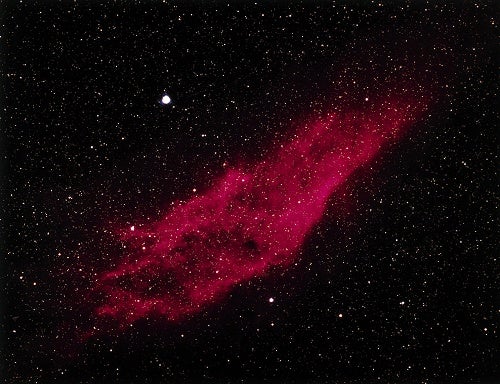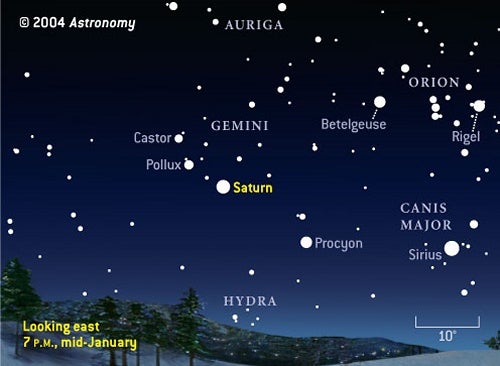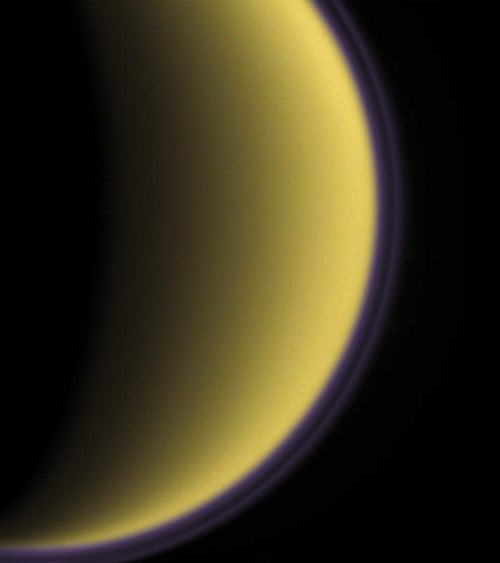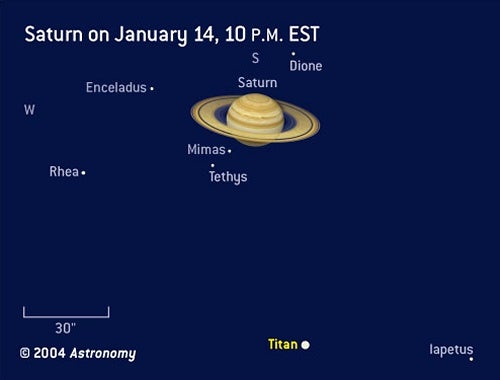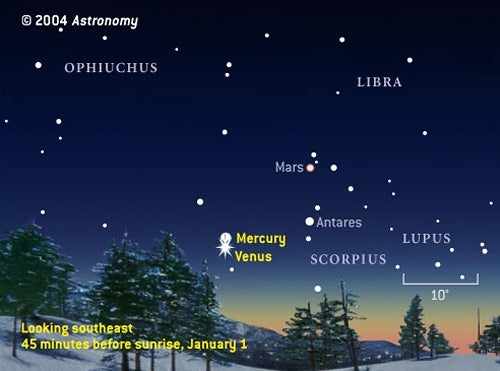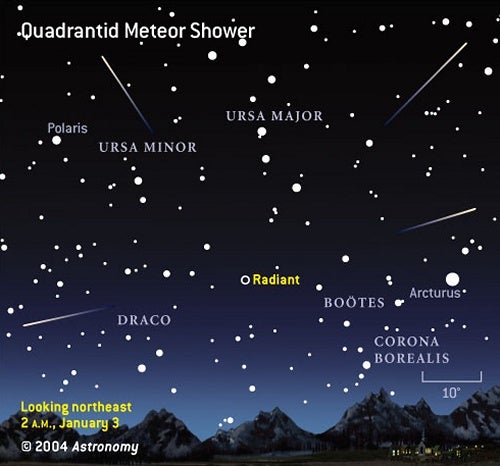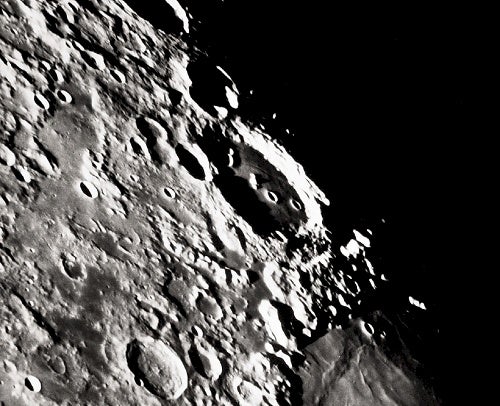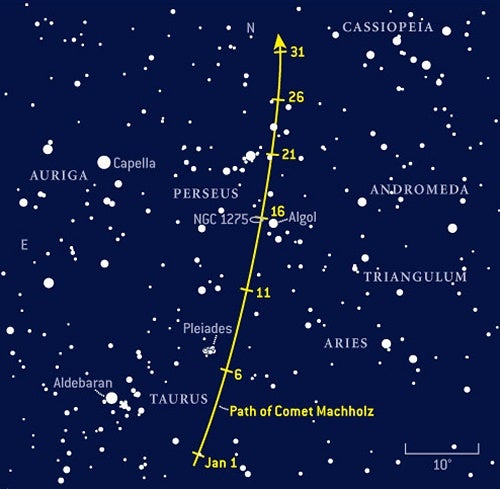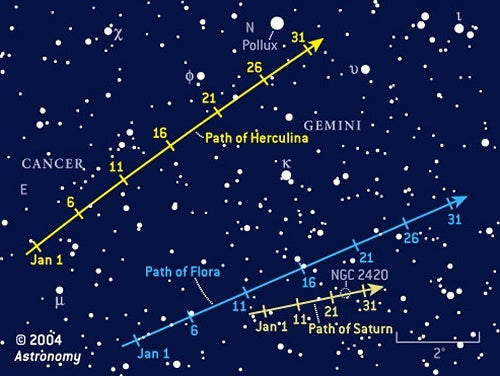Unfortunately, opposition also marks a time when shadows disappear — and shadows help give Saturn a 3-D appearance. In early January, look closely where the edge of Saturn’s globe covers the rings, and you will see a dark line. A couple of days before opposition, that line becomes invisible. But as the nights roll by after opposition, the shadow reappears on the opposite side and slowly thickens into an obvious strip.
Your best view of Saturn, or any object for that matter, comes when it stands highest in the sky. That position minimizes the turbulence caused by Earth’s atmosphere and any local heat sources.
In centuries past, planets were recognized as special because, unlike other bright points of light in the sky, they wandered. Every week, compare Saturn’s position with the bright stars Pollux and Castor. The planet’s path is a combination of its own movement and Earth’s faster pace.
Faster yet are the inner planets Mercury and Venus. In the 4 weeks beginning December 20, Mercury rises above Venus in the morning sky, executes a hairpin turn (from our perspective), and then drops back beneath the blazing beacon. It would be cool to make a time-lapse movie of this event, something within easy reach using a digital camera and software.
Mars continues to speed eastward against the rising stars at dawn. It is the modest, rusty-orange “star” to the upper right of Venus. The second orange object in the area is the red supergiant Antares, whose name means “rival of Mars.” Antares lies lower than Mars during the first 10 days of January then pulls away to the planet’s right as seen from the Northern Hemisphere. You can tell the two apart because Antares shines brighter than Mars all month. A lovely waning crescent Moon joins the pair the morning of the 7th.
Jupiter rises around midnight in the company of Virgo the Maiden and that constellation’s brightest star, blue-white Spica. The giant planet easily dominates the southern sky as dawn approaches. For lucky observers in southern Australia, from Perth to Adelaide, the Moon covers Jupiter during daylight January 4.
Veteran comet-hunter Don Machholz discovered his 10th comet in late August, scooping the search programs that use robotic telescopes. Comet C/2004 Q2 (Machholz) should peak this month at around 4th magnitude, so you’ll be able to see it with the naked eye from a dark location. With the Moon out of the way and January 7 being a Friday night, head to the country with your binoculars and a telescope. You won’t want to miss the comet’s thin blue ion tail streaking just above the Pleiades while its yellow-white dust tail curves through the rich star group. If you stay in the city, you’ll risk having skyglow eat it all up except for the condensation around the comet’s core.
Probably the third favorite meteor shower of the year, after the Perseids and the Geminids, peaks the morning of January 3. The Quadrantids can reach a rate of 120 meteors per hour — higher than its more famous cousins — but January weather and a brief peak that severely limits the number visible on any other night conspire against the shower. This year, light from the Last Quarter Moon will take another notch out of the Quadrantids. What appear to be “shooting stars” are, in reality, grains of dust burning up as they slam into Earth’s upper atmosphere at 92,000 mph (148,000 km/hour).
The California Nebula (NGC 1499) in Perseus has to rank among the most widely recognized and photographed clouds of hydrogen in the sky. Although possible to capture in a 30-second exposure on ISO 400 film, the California remains difficult to detect visually. It eluded such great observers as William and John Herschel and Lord Rosse. It had to await the eagle eyes of E. E. Barnard, who discovered several large objects by sweeping the sky with a 6-inch refractor at low power.
More than any instrument, you will need a sky as black as possible to spy it. The California has such low contrast that even a little bit of skyglow from cities, the Moon, or snow cover will hide it.
Next, you have to be truly dark adapted. Allow at least 30 minutes for your pupils to dilate. As much as possible, avoid looking at even a red flashlight; cover your observing eye while reading star charts.
Begin your search with binoculars, sweeping slowly back and forth across the area. In most cases, you won’t so much see a nebula as detect a rise and fall in the background brightness. The northeastern edge of the California has the most contrast. Sweeping uses the eye/brain combination’s built-in survival skill to detect moving objects in low light conditions. Large telescopes won’t help because their narrow fields of view will peer right through the ghostly sheet.
Several observers have seen the California using only a paper tube and a nebula filter. Such a high-tech filter is an invaluable accessory for even the casual deep-sky observer. Manufacturers design nebula filters to block out light except at the specific wavelengths emitted by ionized gas, thereby cranking up the contrast.
Starkly opposite the California Nebula in every way is the diminutive planetary nebula IC 2003. Although it glows faintly at magnitude 11.5, its tiny, 7″-diameter disk gives it a lot of contrast. In many ways, IC 2003 resembles a fainter echo of the planet Uranus. Try passing a nebula filter back and forth between your eye and the eyepiece. This so-called blinking technique makes small planetaries pop out of the field because the filter suppresses surrounding stars.
Don’t confuse Saturn with either of the bright stars above it: Castor and Pollux in Gemini. Both stars rise before Saturn, and the planet, which shines at magnitude -0.4, appears noticeably brighter. At opposition, Saturn lies 7° south of Pollux. Between January 25 and 27, the ringed planet slides in front of the open star cluster NGC 2420. This 8th-magnitude cluster creates a pretty backdrop, but will make identifying the planet’s moons much harder.
Saturn’s disk measures 20.6″ across at opposition and its spectacular rings span 46.7″ at their widest. Saturn lies about 750 million miles from Earth — a fair distance, but close enough that even the smallest scope will show the rings easily. You should have no problem spying the Cassini Division, which separates the outer A ring from the brighter B ring. With a large scope, you also should be able to spot the innermost C ring.
As Saturn nears opposition and the Sun’s light comes from almost directly behind Earth, the shadow that the planet casts on the rings appears to shrink. It actually disappears from view the week of opposition. Earthly atmospheric conditions and the size of your telescope affect the shadow’s visibility, with large scopes better able to follow the declining shadow. How long can
you keep track of the planet’s shadow on the rings?
The day after opposition, January 14, should mark the climax of the 7-year voyage of the Huygens spacecraft. This instrument-packed probe, a vital part of the Cassini spacecraft, will descend through the atmosphere of Saturn’s largest moon, Titan. It may reach the moon’s surface — to crash or to splash, no one knows. The probe could land on solid ground or in a sea of liquid methane.
There’s something exhilarating about viewing a celestial object when a space probe performs some spectacular feat. On January 13/14, you can find Titan northeast of Saturn; the following night, the moon sits due north of the planet. Check the Cassini/Huygens web site (saturn.jpl.nasa.gov/home/index.cfm) for up-to-date times of Huygens’s descent into Titan’s atmosphere.
Almost any telescope reveals Titan, which glows at magnitude 8.3. On January 6/7, Titan lies south of Saturn, and the moon returns to that position again one orbit later, on January 22/23. Don’t confuse Titan with the 8th-magnitude star that lies north of Saturn January 17/18. Titan lies west of Saturn that night.
Two-faced Iapetus glows at 12th magnitude in early January but brightens by a factor of five by the end of the month, when we see more of its brighter hemisphere. During January, Iapetus moves from east of Saturn to the western side, passing due
north on the 16th.
By the time the night is half over, you can start looking for Jupiter. The giant planet rises around 1 a.m. on New Year’s Day but breaks the eastern horizon by 11 p.m. on the 31st. Jupiter spends the month 6° northwest of Virgo’s brightest star, Spica. You’ll also find the planet 5° above a fat crescent Moon on the 4th and 1° north of a gibbous Moon on the 31st.
Backyard telescopes give wonderful views of Jupiter because the planet has a relatively large disk. This month, it averages 38″ across, making details easy to see. The two dark equatorial belts are the most obvious sights at any magnification. It takes a few minutes of patient observing to accustom your eyes to seeing smaller and finer features — so don’t rush. Moments of steady atmospheric seeing will reward you with great detail.
Avoid the temptation to observe a planet as soon as it rises, especially in winter. The combined effects of atmospheric turbulence, particularly when viewing through thick layers of air near the horizon, and local turbulence created by residential heat during the colder months, deliver poor views. Don’t blame your scope immediately if an image lacks clarity — allow it to cool to the outside temperature and let the planet rise at least 10° to 15° above the horizon before expecting a good image.
After Jupiter appears, there’s another long wait before the next planet rises. Mars clears the horizon by 5 a.m. local time throughout January. On the 1st, it stands 7° above the 1.0-magnitude star Antares, the famous “rival of Mars.” Mars loses the rivalry this month, shining at magnitude 1.5, but the pair appears striking nonetheless. Check out the colors of both objects. Antares shines with an orange hue because of its relatively cool surface temperature, around 4,500 kelvins. Although Mars shines with a similar color, it has nothing to do with temperature. Mars appears ruddy because sunlight reflects off its rust-colored soil.
The view of Mars through a telescope proves disappointing this month because its disk spans a meager 4″. But watch for the pretty crescent Moon as it passes 5° to the right of the planet January 7. Mars moves from Scorpius into Ophiuchus January 5 and remains there the rest of the month.
Mercury and Venus perform an elegant dance in early January, but you’ll need a clear southeastern horizon to spot them. On the 1st, Mercury rises a few minutes before 6 a.m. local time and stands 1.1° northwest of Venus. Each successive morning, Mercury swings to the west of Venus. By the 8th, it stands 0.8° west of Venus and a very thin crescent Moon lies to the pair’s right. Mercury lies due west of Venus the following morning, when both planets can be seen in a low-power field of view.
Mercury and Venus appear closest to each other January 13, when only 0.3° separates them. That morning, the pair lies 6° above the southeastern horizon 30 minutes before the Sun rises. Following their close conjunction, both planets dip into brighter twilight, with Mercury sinking much faster. Although the innermost planet brightens a few tenths of a magnitude, it becomes lost in the Sun’s glare by the third week of the month.
At magnitude -3.7, Venus shines far brighter than Mercury. Venus has an angular diameter of 11″ and appears 93-percent lit. Mercury glows dimmer, at magnitude -0.4 in early January, and shows a 69-percent-illuminated disk measuring just 6″ across.
The Quadrantid meteor shower peaks the morning of January 3. The year’s first shower has produced high rates in recent years, up to around 120 meteors per hour. (Such great numbers appear only under a pitch-black sky with the radiant overhead, however; observed rates almost always are lower.) Unfortunately, the high rate lasts only several hours — observers rarely see many meteors even 1 day before or after the peak. Despite the large number of meteors, the short duration and often cold, cloudy weather this time of year make the Quadrantids poorly observed.
This year, astronomers expect the peak to come around 7 a.m. EST (4 a.m. PST) January 3. The Last Quarter Moon then lies high in the morning sky, however, standing just 7° from Jupiter. So while the timing of the shower favors much of the United States, the bright Moon will attenuate the number of visible meteors. Still, the potential for a good show remains. Just be sure to dress warmly, in layers, and take occasional breaks to keep from getting overly chilled.
Quadrantid meteors appear to radiate from a point in the northeastern corner of Boötes the Herdsman. This region used to belong to a now-defunct constellation known as Quadrans Muralis the Wall Quadrant (or Mural Quadrant), which still lends its name to the shower.
Meteors arise when bits of cosmic debris enter Earth’s atmosphere and burn up from friction with the air, producing bright streaks of light. Most meteor showers result from Earth plowing through a stream of such debris, usually left behind by a comet after innumerable trips around the Sun. Until recently, however, the Quadrantids had no identified parent comet. That changed in 2003, when Peter Jenniskens of the SETI Institute announced that
near-Earth asteroid 2003 EH1 had orbital characteristics closely matching those of the Quadrantid meteor stream. Astronomers think this object is the biggest remnant of a comet’s breakup and provides the first direct link to the annual shower.
Just off the northwestern shore of Mare Crisium lies the fine crater Cleomedes. Because it lies near the limb of the Moon, this 78-mile-diameter (126 km) crater appears foreshortened, with its north-south extent noticeably longer than its east-west dimension. A few small craters and an elongated central mountain chain dominate the crater’s floor, which otherwise appears relatively flat. The crater’s walls tower 1.5 miles (2.5 km) above the floor, and a large crater called Tralles breaks the northwestern wall. When the Sun strikes Cleomedes at a low angle, you can spot a few linear rilles carving the crater floor. Look for the Sun to rise over this region when you see the new crescent in the evening sky January 13.
No matter how cold it gets, bundle up, step outside, dark adapt, and have a look at a lovely comet. Passing just outside Earth’s orbit, Comet C/2004 Q2 (Machholz) should be cresting around 4th magnitude as it scoots past the brilliant Pleiades star cluster January 7. The pair will be visible to the naked eye from rural areas in a celestial replay of Comet C/2001 Q4 (NEAT)’s passage by the Beehive star cluster last May.
Although no one knows for sure how long the tail will grow, we do know we’ll be seeing it a bit from the side, so the tail should be streaming in the direction of the Pleiades. If we’re lucky, the comet will display both a decent dust tail and a nice blue ion tail. From the city, Comet Machholz may appear as a tail-less, fuzzy ball.
The ion, or gas, tail comes from atoms and molecules energized by the Sun’s ultraviolet light. They subsequently emit visible light as the electrons drop to a lower energy state, a process called fluorescence. The gas tail appears straight because the ions stream away from the Sun on the wings of the speedy solar wind.
The dust tail is just that, the dirt part of the “dirty snowball” that forms the comet’s nucleus. Sunlight sublimates the snowball’s ice (turning it directly from solid to gas) and releases dust particles in the process. The dust glows by reflecting sunlight. The particles get pushed away from the Sun by the gentle pressure of solar radiation, so they tend to keep orbiting with the comet. This imparts a nice curved shape to the dust tail.
Although the meeting with the Pleiades will highlight the month, Comet Machholz has another intriguing rendezvous. On the nights of January 15 and 16, the comet’s tails probably will obscure much of the Perseus galaxy cluster, which is centered on NGC 1275.
With telescopes now pointing toward Saturn, it’s easy for asteroid hunters to hop over to two nice targets. Sometime between January 15 and 20, slide 1° (about two lunar diameters) due north of the ringed planet. There, the eighth asteroid to be discovered, Flora, glows at magnitude 8.5. Use the
finder chart to locate it on other nights.
The high-numbered rock 532 Herculina passes 1° south of Pollux at the end of January. Spanning 129 miles (207 km), Herculina is considerably bigger than Flora’s 86-mile (138 km) diameter. The main reason Herculina glows a little fainter (at magnitude 8.9) than Flora is that it lies farther from Earth, but it also reflects about 5 percent less light.
With the profusion of Milky Way stars in the background, the asteroids will be camouflaged. A good way to identify them is by detecting their telltale motion across the sky. On the night of January 23, each asteroid will pass south of its own 7th-magnitude field star. Use another field star to anchor your sketch, then come back in about 3 hours to see that the asteroids have moved. You’ll have to wait until mid-evening for them to rise well above the eastern horizon.

